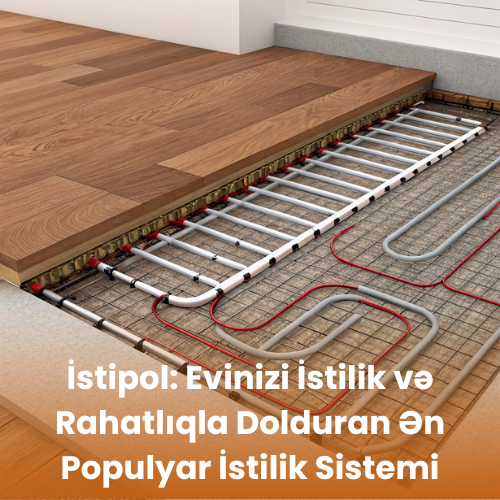Underfloor Heating: The Most Popular Heating System That Fills Your Home with Warmth and Comfort

Introduction
A warm and cozy home is every person’s dream, especially during the winter months in Azerbaijan. If you’re looking for an efficient heating system that provides both comfort and energy savings, underfloor heating is the ideal choice! In recent years, this system has gained popularity in both new buildings and homes undergoing major renovations. So, what is underfloor heating, and why has it become so popular? Let’s find out!
What Is Underfloor Heating?
Underfloor heating is a system installed beneath the floor that heats the room from the ground up. Its main advantage is that it distributes heat evenly across the space, making it more energy-efficient and comfortable than traditional heating methods.
How Underfloor Heating Works
There are two main types of underfloor heating:
-
Water-based: Hot water flows through pipes laid under the floor, heating the surface.
-
Electric: Special cables or mats are placed under the floor, warming it using electrical energy.
History and Comparison with Traditional Heating
Underfloor heating has been used since Roman times. Compared to traditional radiator heating, it is:
-
More energy-efficient
-
Aesthetic and silent
-
Doesn’t circulate dust or air
Types of Underfloor Heating
-
Water-based Underfloor Heating: Operates with gas or combi heating systems, ideal for larger spaces and long-term use.
-
Electric Underfloor Heating: Perfect for smaller spaces or individual rooms.
Benefits of Underfloor Heating
-
Energy Efficiency: Reduces heating costs by 30–40%.
-
Environmentally Friendly: Provides clean and safe heating without harmful emissions.
-
Comfort: Enjoy the comfort of a warm floor and a cozy atmosphere throughout your home.
Installation and Main Steps
-
Preparation of Materials and Tools: Insulation and piping are prepared.
-
Design and Calculation: Created based on room size and flooring material.
-
Installation: Pipes or heating mats are laid, followed by concrete and floor covering.
Compatible Flooring Materials
-
Tile and ceramic
-
Laminate and parquet
-
Vinyl and other synthetic materials
Care and Maintenance
-
Avoid placing heavy or sharp objects that could damage the floor.
-
Perform annual pressure and filter checks for water-based heating.
-
Check the thermostat periodically for electric heating.
Cost and Long‑term Benefits
Although the initial investment in underfloor heating is higher, it leads to significant long‑term savings through reduced energy and heating expenses.
Frequently Asked Questions
-
How much energy does underfloor heating consume?
-
What flooring works best with underfloor heating?
-
Is it challenging to maintain an underfloor heating system?
-
Can underfloor heating be installed in an existing apartment?
-
In which spaces does underfloor heating work best?
What to Consider When Choosing Underfloor Heating
-
The climate of your area
-
The construction and flooring of your home
-
Cost and energy efficiency
-
Quality of installation and service
How Underfloor Heating Improves Quality of Life
-
No more cold floors underfoot
-
Reduced dust and allergens in the air
-
Comfortable, quiet heating throughout the home
-
Even distribution of warmth in every room
Conclusion
Underfloor heating is more than just a heating system — it’s a technology that ensures comfort and warmth for you and your family. When designed and installed properly, it will be an efficient and cozy solution for many years to come.
